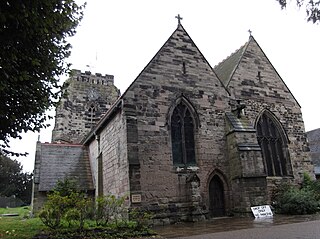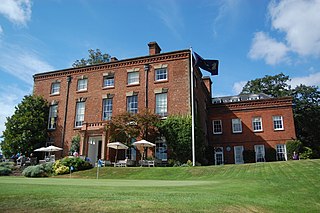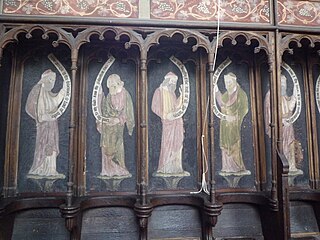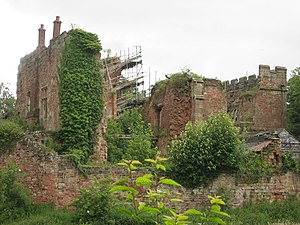
Ashby de la Zouch Castle is a ruined fortification in the town of Ashby-de-la-Zouch, Leicestershire, England. The castle was built by William, Lord Hastings, a favourite of Edward IV, after 1473, accompanied by the creation of a 3,000-acre (1,200 ha) park. Constructed on the site of an older manor house, two large towers and various smaller buildings had been constructed by 1483, when Hastings was executed by Richard, Duke of Gloucester. The Hastings family used the castle as their seat for several generations, improving the gardens and hosting royal visitors.

Polesworth Abbey was a Benedictine nunnery in Polesworth, North Warwickshire, England.

Sherborne Castle is a 16th-century Tudor mansion southeast of Sherborne in Dorset, England, within the parish of Castleton. Originally built by Sir Walter Raleigh as Sherborne Lodge, and extended in the 1620s, it stands in a 1,200-acre (490 ha) park which formed a small part of the 15,000-acre (61 km2) Digby estate. Within the grounds lie the ruins of the 12th-century Sherborne Old Castle, now in the care of English Heritage.

Arbury Hall is a Grade I listed country house in Nuneaton, Warwickshire, England, and the ancestral home of the Newdigate family, later the Newdigate-Newdegate and Fitzroy-Newdegate families.

Edgbaston Hall is a country house in the Edgbaston area of Birmingham, England.

Scrivelsby is a village and ecclesiastical parish in the East Lindsey district of the County of Lincolnshire, England. It is situated 2 miles (3.2 km) south of Horncastle and is on the B1183 road 1 mile (1.6 km) east from the A153 road. It is administered by the civil parish of Mareham on the Hill.

Astley is a small village and civil parish within the North Warwickshire district of Warwickshire, England. In the 2001 census it had a population of 219, reducing slightly to 218 at the 2011 census. Astley is Knebly in George Eliot's Mr Gilfil's Love Story, published in 1857. Eliot's parents were married in the church.

Newdigate is a village and civil parish in the Mole Valley borough of Surrey lying in a relatively flat part of the Weald to the east of the A24 road between Dorking and Horsham, 13 miles (21 km) ESE of Guildford and 25 miles (40 km) south of London. Neighbouring parishes are Charlwood, North Holmwood, South Holmwood, Leigh and Capel.

Witherley is a village and civil parish in the Hinckley and Bosworth district of Leicestershire, England. The civil parish of Witherley includes Atterton, Fenny Drayton, and Ratcliffe Culey as well as the village of Witherley itself. The population of the civil parish at the 2011 census was 1,373.
Morebarne or Moore Barn is a grange originally belonging to the Abbey of Merevale, near Orton on the Hill in Sparkenhoe Hundred, Leicestershire, England. It is mentioned in possession of Robert Bradshaw in 1567, and as the 'capite' of Robert Bradshaw esq. the brother of John Bradshaw of Orton on the Hill in 1609. They were descendants of Hugh Bradshaw of Nantwich in Lancashire, who purchased the manor in 1546. It was later sold to the Steeles who bought the manor, the estate and the attached "mansion house", sometime after 1640.

Holland William Hobbiss, was an English architect in the Birmingham area. He traded under the names Holland W. Hobbiss and Partners and Holland W. Hobbiss and M. A. H. Hobbiss.

Charles Edward Bateman FRIBA was an English architect, known for his Arts and Crafts and Queen Anne-style houses and commercial buildings in the Birmingham area and for his sensitive vernacular restoration and extension work in the Cotswolds.

Lieutenant-General Sir Edward Newdigate Newdegate, was a British Army officer. Until 1887 he was Edward Newdigate.

The Battle of Stow-on-the-Wold took place during the First English Civil War. It was a Parliamentarian victory by detachments of the New Model Army over the last Royalist field army.

Bolehall is a village in Staffordshire, England, part of the Tamworth Conurbation. The village sits on the south bank of the River Anker. The parish of Bolehall and Glascote, was historically part of Warwickshire.
Colonel John "Tinker" Fox (1610–1650), confused by some sources with the MP Thomas Fox, was a parliamentarian soldier during the English Civil War. Commanding a garrison at Edgbaston House in Warwickshire – a location that guarded the main roads from strongly parliamentarian Birmingham to royalist Worcestershire – Fox operated largely independently of the parliamentarian hierarchy, all factions of which tended to view him with suspicion. Though lauded by the parliamentarian press for his "continual motion and action", to royalist propagandists Fox became an icon of dangerous and uncontrolled subversiveness, being decried as a "low-born tinker" whose troops "rob and pillage very sufficiently". By 1649 Fox's notoriety was such that he was widely, though wrongly, rumoured to be one of the executioners of Charles I.

Seckington is a village and civil parish in North Warwickshire, about 4 miles (6 km) northeast of Tamworth. The B4593 road between Tamworth and Appleby Magna runs through the parish, passing about 100 yards (91 m) north of the village. Seckington shares a parish council with Newton Regis and No Man's Heath. Forming part of the border with Staffordshire, it is the second most northerly settlement in Warwickshire, with only No Man's Heath situated further north, and is only 3.5 miles due south of the Derbyshire border.
The year 2012 in architecture involved some significant architectural events and new buildings.
The year 2013 in architecture involved some significant architectural events and new buildings.

Newdigate House is a Grade II* listed building on Castle Gate, Nottingham.


















